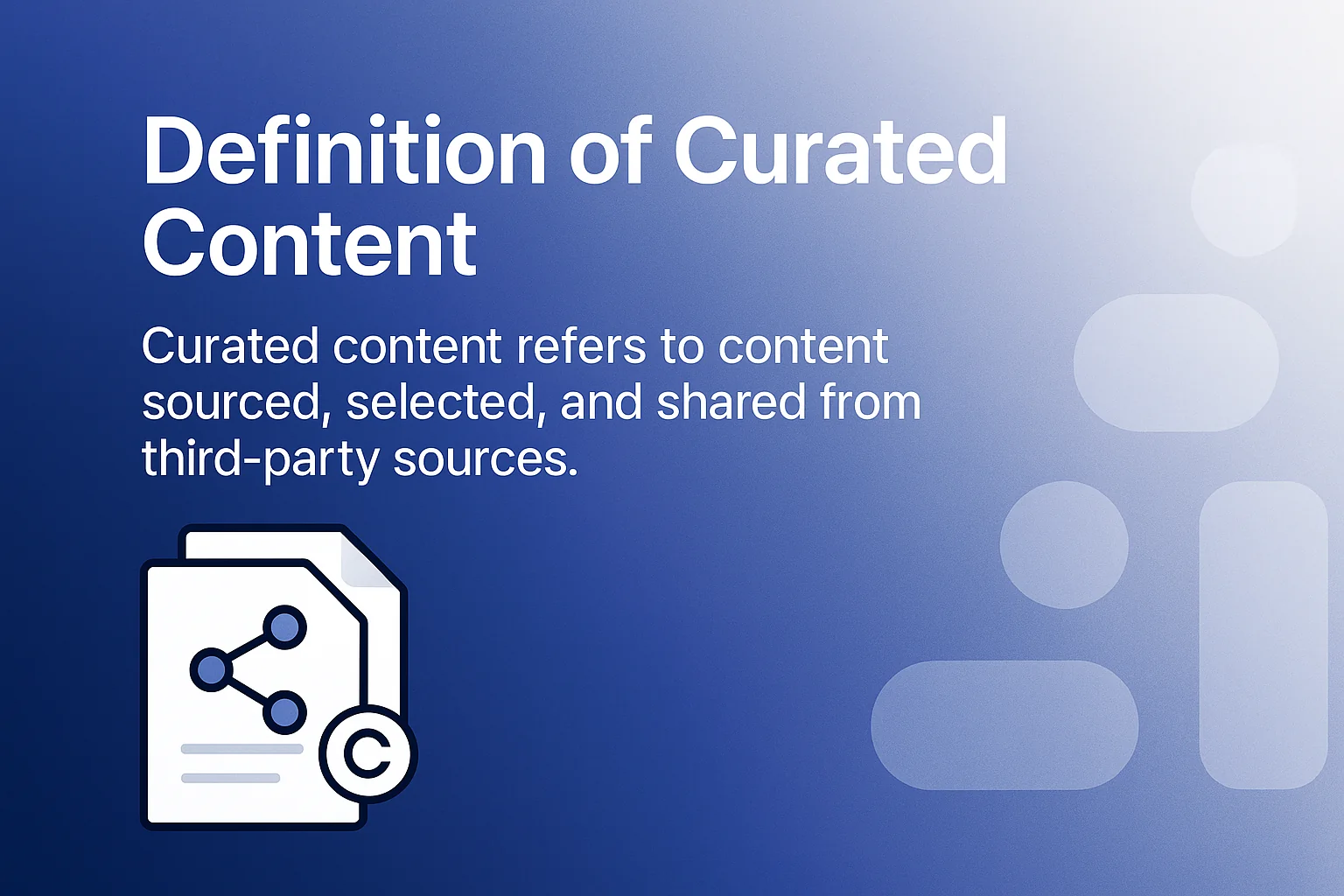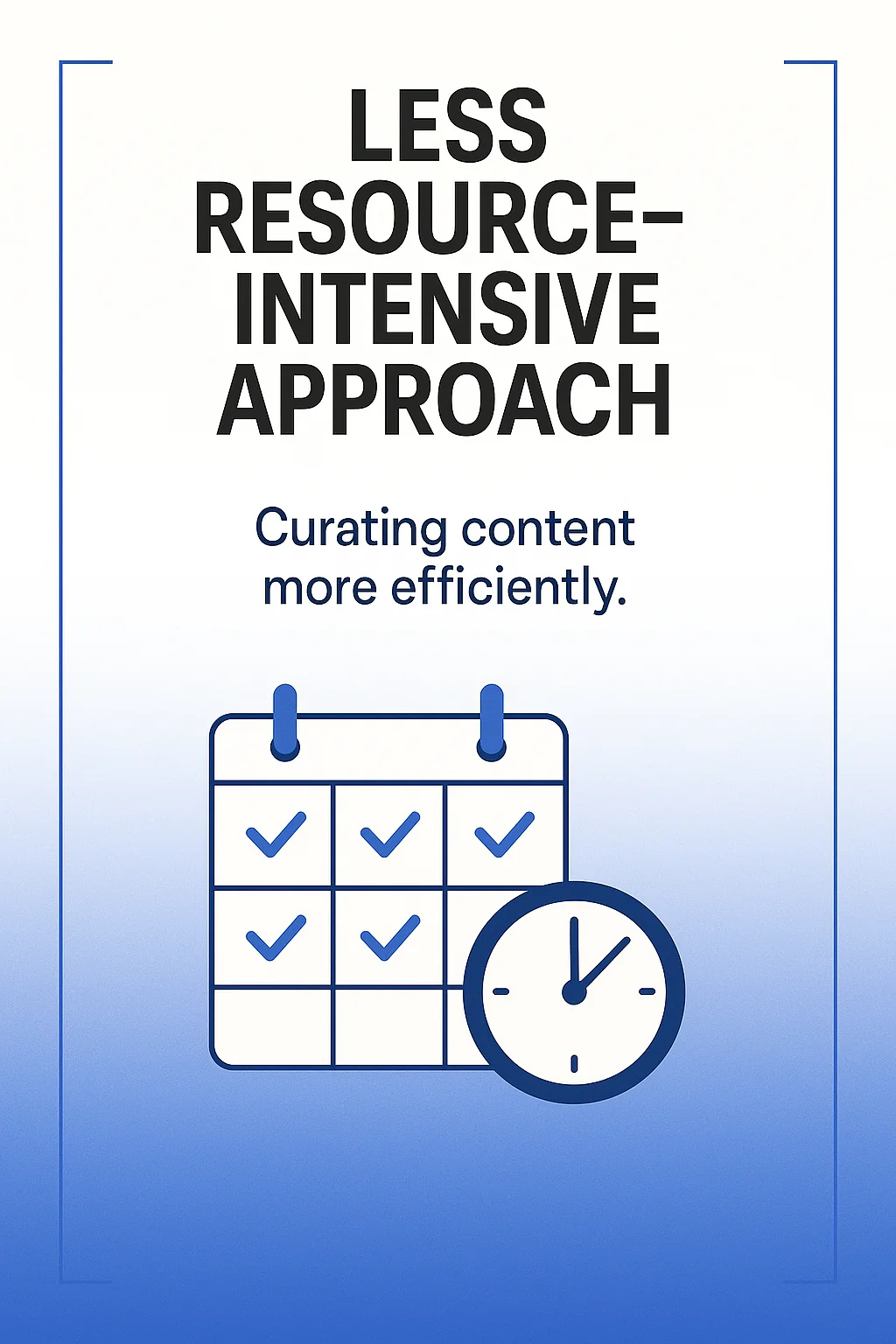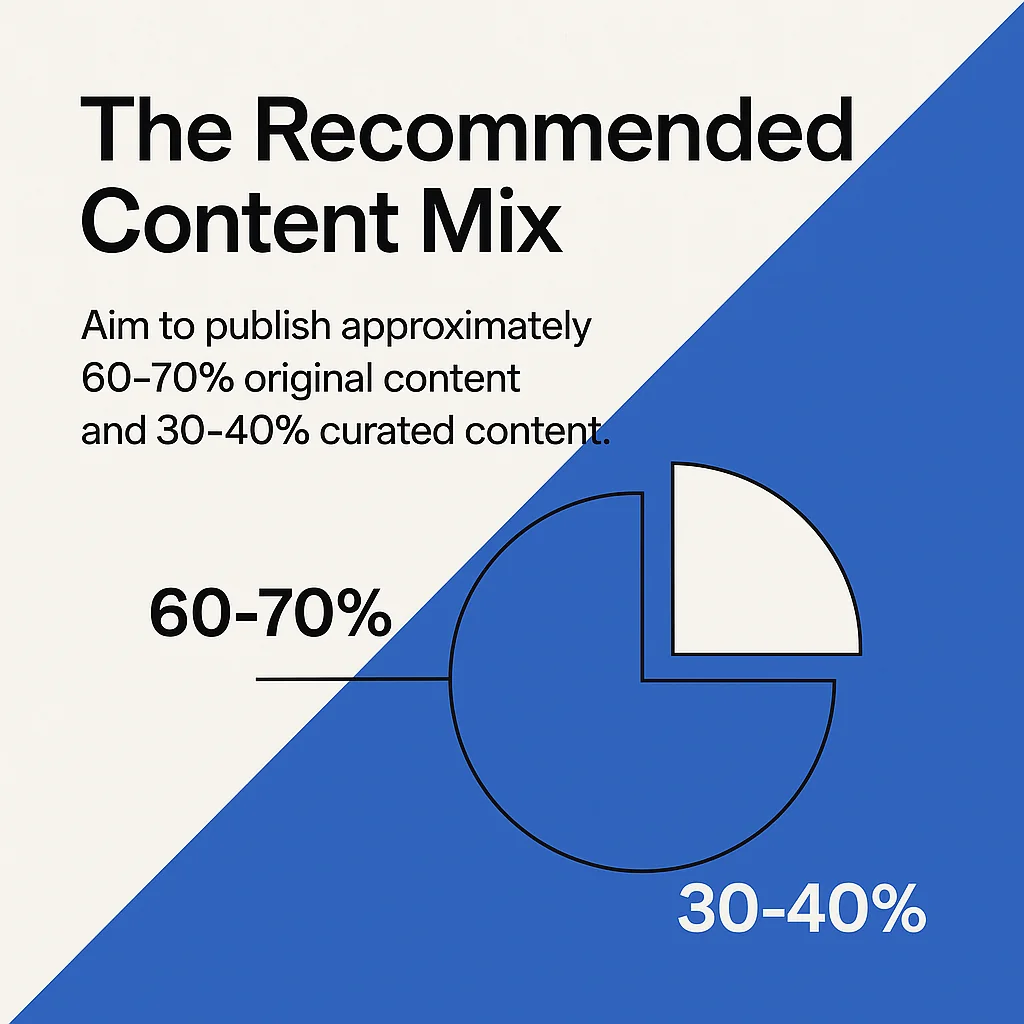Content marketers face resource constraints and increasing pressure to deliver value across multiple channels. The answer lies in strategic balance rather than choosing sides.
Original content builds brand authority and drives organic search rankings. Curated content maintains consistent publishing schedules whilst reducing production costs. Most successful brands integrate both approaches in complementary ways rather than viewing them as competitors.
The optimal mix depends on your specific goals, available resources, and audience expectations. Understanding the distinct advantages and limitations of each approach enables you to allocate efforts effectively and maintain audience engagement without burning out your team.
What Is Original Content?
Original content represents material created entirely by your brand. This includes blog posts, research reports, videos, podcasts, and social media posts developed from scratch to showcase your unique expertise and perspective.
This type of content creation reflects your brand’s voice and addresses your audience’s specific challenges. Rather than resharing existing material, you’re producing new insights that didn’t exist before you published them.
Original content requires significant investment in research, writing, design, and production. However, it positions your brand as a thought leader rather than simply an aggregator of information.
Characteristics of Original Content
Original content demonstrates expertise through unique analysis and fresh perspectives. You’re not summarising what others have said but adding new value to industry conversations.
This content type typically includes proprietary research, original case studies, expert interviews, and detailed how-to guides based on your team’s experience. Each piece should offer something your audience cannot find elsewhere.
The content must be fixed in a tangible medium and represent your creator’s expression rather than just an idea. This ensures both legal protection and recognition for the effort invested.
What Is Curated Content?
Curated content is the act of finding and responsibly sharing already-created content, always giving proper credit to the original creators. You’re selecting valuable material from other sources and presenting it to your audience with context and commentary.

Content curation involves filtering through vast amounts of information to identify the most relevant and valuable pieces for your specific audience. You become a trusted filter rather than just another noise source.
This approach differs fundamentally from content creation. Instead of starting from scratch, you’re leveraging existing high-quality material and adding your perspective through introductions, summaries, and analysis.
Types of Curated Content
Curated content can take multiple forms across different platforms. Social media posts sharing industry news with your commentary represent one common approach.
Email newsletters featuring roundups of relevant articles provide consistent value whilst requiring less production time. Blog posts that compile expert opinions on trending topics combine multiple perspectives into single resources.
Social media feeds that share third-party research, infographics, and thought leadership pieces help maintain active presence when original content production lags. The key is always providing proper attribution and adding your unique perspective.
Benefits and Advantages of Original Content
Original content tends to perform better in terms of brand recall, authority building, and search engine optimisation, since it is unique and tailored to the brand’s voice. This makes it particularly valuable for establishing market position.

Creating original material allows you to control messaging completely. You decide what angles to explore, which data to highlight, and how to frame discussions around your products or services.
Original content generates backlinks more effectively than curated material. Other websites prefer linking to primary sources rather than aggregations, improving your search rankings over time.
Building Brand Authority
Original content positions your brand as an industry expert rather than simply a curator. When you consistently publish valuable insights, your audience views you as a trusted source of expertise.
This authority translates into stronger customer relationships and improved conversion rates. Prospects trust brands that demonstrate deep subject matter knowledge through original research and analysis.
Your unique perspective differentiates you from competitors who share similar curated content. Original content creates memorable associations between your brand and specific industry topics.
SEO and Traffic Advantages
Search engines prioritise unique content when determining rankings. Original material gives you opportunities to rank for specific keywords and phrases that curated content cannot target effectively.
Your original content can attract featured snippets and appear in AI overviews. These premium search placements drive significant organic traffic to your website.
Long-term traffic growth relies heavily on original content. Whilst curated posts may generate short-term engagement, original pieces continue attracting visitors months or years after publication.
Drawbacks and Disadvantages of Original Content
Original content demands substantial resources that many marketing teams struggle to provide consistently. Research, writing, editing, design, and promotion require significant time investment.
Quality original content cannot be rushed. Comprehensive guides and research reports may take weeks to produce, creating gaps in your publishing schedule.
The cost of original content creation extends beyond staff time. Professional photography, video production, and design work add financial pressure to already stretched marketing budgets.
Time and Resource Intensity
Creating original content requires deep expertise and careful research. Your team must verify facts, conduct interviews, analyse data, and craft compelling narratives.
This time investment becomes particularly challenging when managing multiple channels. Producing original content for your blog, social media, email newsletters, and video platforms simultaneously stretches resources thin.
Small teams often face difficult choices between content quality and publishing frequency. The pressure to maintain consistent schedules can compromise the depth and value of original pieces.
Scalability Challenges
Original content production doesn’t scale linearly with team size. Adding more writers doesn’t automatically double output because quality control and strategic alignment require additional coordination.
Maintaining consistent brand voice across multiple creators presents ongoing challenges. Editorial processes become more complex as teams grow, potentially slowing production rather than accelerating it.
The expertise required for high-quality original content limits your hiring options. Finding writers who understand both your industry and your audience deeply enough to produce valuable content takes time and careful evaluation.
Benefits and Advantages of Curated Content
Curated content can be less resource-intensive than producing original material, making it ideal for maintaining a steady publishing schedule without overextending internal teams. This efficiency enables consistent audience engagement.

Content curation helps you maintain active social media presence during periods when original content production slows. Your audience benefits from valuable information regardless of who created it originally.
Sharing high-quality content from respected sources builds trust by demonstrating your commitment to audience value over self-promotion. This generosity strengthens relationships and positions you as a helpful resource rather than constant advertiser.
Cost and Time Efficiency
Brands that leverage user-generated content can reduce content creation costs and maintain a constant stream of fresh material without production delays. This principle extends to curated content more broadly.

Finding and sharing valuable content requires significantly less time than creating original pieces from scratch. Your team can maintain daily social media activity without the resource drain of constant content creation.
The reduced workload allows your content team to focus creative energy on fewer, higher-quality original pieces. Strategic curation fills gaps whilst reserving resources for content that genuinely requires original creation.
Social Media Sharing and Engagement
Curated content often generates strong engagement on social media platforms. Audiences appreciate discovering valuable resources they might have missed otherwise.
Sharing diverse perspectives from multiple sources creates more interesting feeds than constant self-promotion. Your audience follows you partly for original insights and partly for filtering relevant industry information.
Curated content enables you to participate in trending conversations quickly. Rather than waiting days to produce original commentary, you can share relevant third-party analysis whilst adding your brief perspective.
Drawbacks and Disadvantages of Curated Content
Curated content provides limited opportunity to establish unique brand authority. Whilst sharing valuable resources builds trust, it doesn’t position you as an expert in the same way original insights do.
Over-reliance on content curation can make your brand appear derivative rather than thought-leading. Audiences may question why they should follow you when they could follow the original sources directly.
Curated content offers minimal SEO value compared to original material. Search engines don’t reward aggregation the way they prioritise unique, valuable content that answers user questions comprehensively.
Limited Brand Differentiation
Multiple brands often curate the same popular articles and resources. Your curated content may look identical to competitors’ feeds, making it difficult to stand out.
The commentary you add to curated pieces provides some differentiation, but this value remains limited compared to comprehensive original analysis. Your perspective becomes secondary to the primary source.
Building strong brand recognition requires owning specific topics and perspectives. Curated content alone cannot establish this ownership because the core value originates elsewhere.
Attribution and Permission Requirements
Responsible content curation requires proper attribution to original creators. This ethical obligation protects you legally whilst maintaining industry relationships.
Some content creators restrict sharing or require explicit permission before republication. Navigating these requirements adds complexity to content curation workflows.
Copyright considerations mean you cannot simply republish entire articles. You must provide context, excerpts, and links that drive traffic back to original sources rather than replacing them.
Which Should You Choose: Original vs Curated Content?
The choice between original content and curated content represents a false dichotomy. Successful content marketing strategies integrate both approaches strategically rather than selecting one exclusively.
Your decision framework should consider available resources, audience expectations, and business objectives. Different channels and content types warrant different balances between original creation and curation.
Consider your brand’s maturity and market position when allocating resources. Newer brands may benefit from heavier emphasis on original content to establish authority, whilst established brands can leverage curation more freely.
Decision Framework
Evaluate your team’s capacity honestly. If producing one high-quality original piece weekly strains resources, supplementing with curated content makes strategic sense.
Assess your audience’s content consumption patterns across different platforms. Social media followers may appreciate curated news updates, whilst blog subscribers expect deeper original analysis.
Consider your competitive landscape when allocating resources. If competitors produce minimal original content, investing heavily in creation helps you capture market attention and establish thought leadership.
Channel-Specific Considerations
Different platforms warrant different content approaches. Social media channels benefit from mixed strategies that combine original posts with curated shares.
Your blog should prioritise original content that drives SEO value and establishes expertise. Curated roundup posts can supplement core original articles without replacing them.
Email newsletters provide excellent curation opportunities. Subscribers appreciate filtered industry news alongside your original insights, creating value through both selection and creation.
The Ideal Mix: Balancing Original and Curated Content
Most content marketing experts recommend dedicating approximately 60-70% of efforts to original content and 30-40% to curation. This balance maintains consistent publishing whilst building brand authority.

The specific ratio depends on your resources and objectives. B2B technology companies competing on thought leadership may skew toward 80% original, whilst agencies serving multiple clients might use 50-50 splits.
Track performance metrics for both content types to refine your mix over time. Engagement rates, traffic sources, and conversion data reveal which balance serves your audience most effectively.
Strategic Integration Approaches
Integrate original and curated content within individual pieces rather than treating them as separate categories. Original blog posts can reference and build upon curated research from authoritative sources.
Use content curation to identify gaps in industry coverage that warrant original content creation. When you notice important questions receiving inadequate answers, you’ve found opportunities for valuable original pieces.
Create content calendars that alternate between original deep dives and curated roundups. This rhythm maintains consistent publishing whilst managing resource allocation effectively.
Measuring Success and Adjusting
Monitor engagement metrics separately for original and curated content. Compare comments, shares, time on page, and conversion rates to understand which type resonates most strongly.
Track traffic sources to assess SEO impact. Original content should drive increasing organic search traffic over time, whilst curated pieces may generate more immediate social referral traffic.
Survey your audience periodically to understand content preferences. Direct feedback reveals whether your current balance meets expectations or requires adjustment.
| Content Type | Primary Benefit | Resource Requirement | Best Use Case |
|---|---|---|---|
| Original Content | Builds authority and SEO value | High time and cost investment | Blog posts, research reports, comprehensive guides |
| Curated Content | Maintains consistent publishing | Low time and cost investment | Social media updates, newsletters, industry roundups |
Quick Answers to Common Questions
What qualifies as original content?
Original content is material uniquely created by an author, not copied from other sources, and expresses new ideas or perspectives. It must be an original work of authorship fixed in a tangible medium and represent the creator’s own expression rather than just an idea.
How do I give proper credit when curating content?
Always attribute curated content to original creators with clear citations, links back to source material, and explicit acknowledgement of authorship. This ethical practice protects you legally whilst maintaining professional relationships within your industry.
Can curated content help with SEO?
Curated content provides minimal direct SEO benefit because search engines prioritise unique material. However, maintaining active social media presence through curation can drive referral traffic and support broader digital marketing objectives that indirectly benefit search performance.
Building Your Content Strategy
Successful content marketing requires strategic thinking about resource allocation. Start by auditing your current content mix to identify gaps and opportunities.
Document your team’s capacity honestly. Calculate how many hours weekly you can dedicate to content creation and curation, then plan your publishing schedule accordingly.
Experiment with different ratios over three-month periods. Track performance metrics to determine which balance delivers the strongest results for your specific audience and business objectives.
The most effective content strategies evolve based on performance data and audience feedback. Regular assessment ensures your approach remains aligned with changing market conditions and audience expectations.
Remember that consistency matters more than perfection. A sustainable mix of original and curated content that you can maintain long-term outperforms ambitious plans that burn out your team within months.






